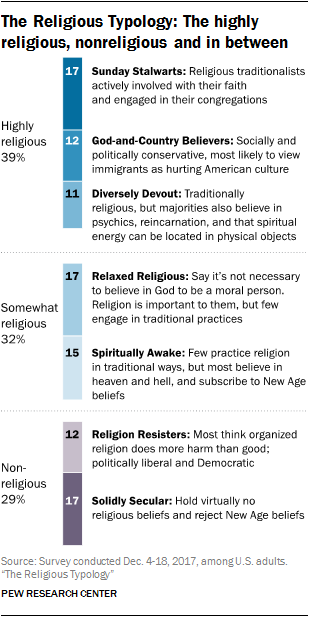Pew Research Center surveys on religion in the United States typically sort Americans by their religious affiliation (or lack of affiliation). But our latest report looks at religion in America in a different way. This new analysis creates a typology that cuts across denominations, sorting Americans into seven groups, or “clusters,” based on their religious and spiritual beliefs and practices, the value they place on their religion, and the sources of meaning and fulfillment in their lives. Rich Morin, a senior editor at the Center, explains how the study was put together, and discusses the role of cluster analysis in creating the typology.
Why do a typology of religion in the first place?

Pew Research Center
When researchers study religion, they usually classify U.S. adults based on their religious denomination or group – the Catholic, Jewish, Baptist, Muslim and assorted other categories familiar to most Americans. Our goal was not to replace traditional religious categories but instead to create categories built around personal religious and spiritual beliefs, as well as behaviors and experiences that are broadly shared by people of different faiths. And, in addition to identifying characteristics that cut across denominational lines, we wanted this new religious typology to illuminate the key differences in belief and practice that exist within religious traditions.
What does this typology tell us about American religion that we didn’t already know?
We believe that this religious typology, based on people’s beliefs and practices rather than on their denomination, offers a new and important way to understand the American religious experience. It identifies both what unites certain people across the boundaries of different religious denominations and also what divides people of the same religious tradition. Beyond the distinctive characteristics of the seven groups, other striking findings include the low level of religious participation among many of those who consider themselves to be religious, widespread New Age beliefs (even among those who are religious in traditional ways), and the many and varied ways that people find meaning and personal fulfillment in their lives.
You grouped survey respondents using something called cluster analysis. What is cluster analysis and how does it work?
 Cluster analysis is a statistical technique that sorts people into groups (clusters) based on a set of characteristics that they share and that distinguish their group from other groups. Researchers first have to decide which variables – in this case, survey questions – to use to form the basis for the analysis. They also specify the number of groups to be produced. At this point, a computer algorithm takes over and objectively sorts individuals into distinctive groups.
Cluster analysis is a statistical technique that sorts people into groups (clusters) based on a set of characteristics that they share and that distinguish their group from other groups. Researchers first have to decide which variables – in this case, survey questions – to use to form the basis for the analysis. They also specify the number of groups to be produced. At this point, a computer algorithm takes over and objectively sorts individuals into distinctive groups.
For this study, respondents were sorted into seven groups based on their answers to 16 questions on their religious and spiritual beliefs and practices, the value they place on their religion, and the other sources of meaning and fulfillment in their lives. The resulting solution grouped respondents into clusters that contained individuals who are similar to each other but dissimilar to members of other groups.
How did you choose these particular 16 questions? What questions did you consider but ultimately leave out?
We initially reviewed hundreds of survey questions to include on the questionnaire. Since many of the questions we considered had appeared in previous Pew Research Center surveys, we were able to conduct cluster analyses on old datasets to test whether combinations of these questions produced interpretable, distinct cluster groups. The questions that fared best on these tests were included among those in our final survey questionnaire. Then, in December 2017, we actually conducted the survey. When it was complete, we did repeated cluster analyses using various combinations of survey questions to determine which clusters produced the most useful typology. Only then did we settle on the 16 that we used to create the final cluster groups.
In deciding whether to include a question, we tested whether it made a meaningful contribution to the formation of the cluster groups; we didn’t want to include two questions when one was sufficient. For example, we used a question that asked people if they believed that spiritual energy can be located in physical things like mountains, trees or crystals, but we decided not to use three other questions about belief in astrology, psychics and reincarnation. We concluded that any one of these four questions effectively measured New Age beliefs so we only needed to add one to capture this aspect of spirituality.
Explain how you wound up using seven clusters in the typology, rather than, say, five or nine.
There is no “right” number of clusters. While a computer algorithm does the heavy lifting in a cluster analysis, researchers decide how many clusters are to be created by the algorithm. So we experimented with different numbers of clusters – five, six, seven and eight. (With anything higher than eight, at least one cluster had too few people to analyze.) We then evaluated each model to determine how effectively it produced cohesive groups that were sufficiently distinct from one another, large enough to be analytically practical, and substantively meaningful. In the end, the seven-cluster model emerged as the strongest from a statistical and substantive point of view, and was deemed best representative of the general patterns seen across all the cluster solutions we tested.



